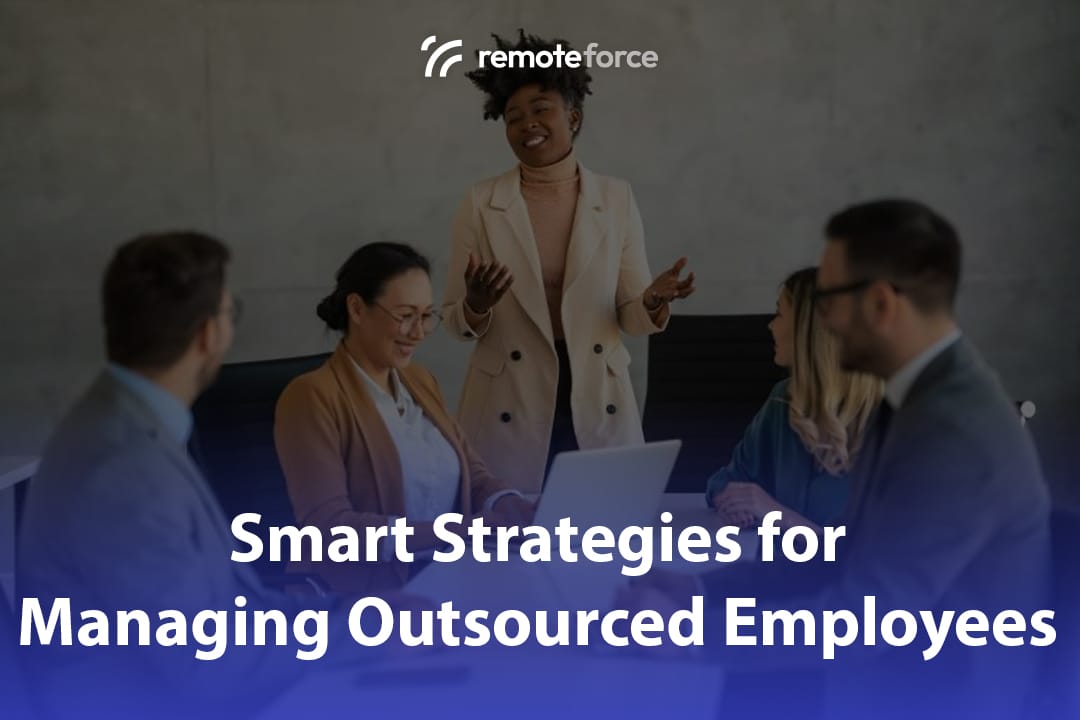Outsourcing manpower to access specialized expertise—be it in digital marketing, web development, accounting, or legal administration—is a powerful strategy for growth. However, the success of this strategy hinges entirely on how effectively you manage your outsourced team.
Unlike traditional employees, outsourced staff are managed by their vendor (the outsourcing company, such as RemoteForce), yet they work directly on your projects and within your workflows. This dual relationship requires a refined management approach focused on clear communication, performance metrics, and cultural integration.
Here are the expert tips for managing your outsourced employees effectively, turning external resources into a seamless extension of your internal team.
Table of Contents
ToggleSmart Ways to Manage Outsourced Employees Effectively

1. Define Clear Roles, Goals, and Deliverables
Ambiguity is the number one killer of outsourcing efficiency. Because the outsourced employee is not physically present in your office, their tasks and priorities must be crystal clear.
- Establish a Master Service Agreement (MSA) and SLA: Before the work begins, ensure the Service Level Agreement (SLA) defines measurable, non-negotiable deliverables (e.g., “Increase website traffic by 15% in Q3,” not “Improve SEO”).
- Create Detailed SOWs (Scope of Work): For each outsourced role, provide a detailed job description and a specific list of responsibilities and expected daily/weekly output. Use project management tools (like Asana or Trello) to assign specific tasks and due dates.
- Align Goals with Business Impact: Ensure the outsourced employee understands why their work matters. For instance, a web developer needs to know that their code performance impacts customer conversion rates.
2. Implement a Structured Communication Cadence
Effective communication bridges the physical and organizational gap between your core team and the outsourced staff. It must be structured, regular, and utilize the right tools.
- Designate a Single Point of Contact (SPOC): Assign one dedicated project manager or team lead from your side to handle all communication and feedback with the outsourced team. This prevents confusion and conflicting instructions.
- Schedule Regular Check-ins: Implement a mandatory communication rhythm:
- Daily Stand-ups (15 minutes): For rapid alignment on tasks and blockers.
- Weekly Planning Meetings (30-60 minutes): To review progress, plan the next cycle, and give strategic direction.
- Monthly Strategy Review: A high-level meeting involving the vendor’s management to review KPI performance and long-term goals.
- Utilize Collaboration Tools: Use shared platforms (Slack, Teams, Zoom) to ensure real-time access. Crucially, ensure the outsourced team has access to the same document repositories and internal communications needed to do their job.
3. Focus on Performance Metrics, Not Micromanagement
The goal of outsourcing is to leverage professional expertise, not to dictate how they work. Focus your management efforts on the results defined in the SLA.
- Define Clear KPIs (Key Performance Indicators): For a Digital Marketing Specialist, track leads generated, conversion rates, or CPA. For an Accountant, track on-time financial reporting accuracy.
- Use Data for Feedback: Instead of saying, “You need to work faster,” say, “The average time-to-close on tickets this week was 4 hours longer than the SLA target; let’s discuss potential roadblocks.”
- Empower Autonomy: Trust the certified experts you hired. Give them the freedom to utilize their expertise to achieve the defined goals. Too much supervision reduces their efficiency and negates the value of their specialized knowledge.
4. Foster Integration and Inclusion (Cultural Fit)
Although outsourced employees are not on your payroll, they are part of your team’s operational flow. Treating them as outsiders erodes motivation and teamwork.
- Introduce Them Properly: Ensure they are formally introduced to the relevant internal teams and stakeholders. Define their role and responsibility clearly within the internal team structure.
- Invite Them to Relevant Meetings: Include them in meetings where their input is needed or where decisions are made that affect their work. This prevents the feeling of being an isolated cog in the machine.
- Share Company Culture (Where Appropriate): While the vendor handles HR functions, share information about your company’s mission, vision, and values. Alignment on purpose drives better performance.
5. Implement Structured Feedback and Review Mechanisms
A formal feedback process is essential to ensure continuous improvement and alignment.
- Bilateral Feedback: The SPOC should provide regular performance feedback directly to the outsourced employee. However, the client should also provide feedback on the employee’s performance directly to the vendor’s dedicated Account Manager.
- Performance Improvement Plans (PIP): If an employee consistently underperforms, engage with the vendor immediately. The vendor is responsible for managing the PIP, training, or replacement of the resource, but the client must provide detailed evidence and documentation.
- Conduct Quarterly Business Reviews (QBRs): Meet with the vendor’s senior management every quarter to review the SLA, discuss satisfaction levels, and plan for future scalability. This proactive approach prevents small issues from escalating.
6. Uphold Legal and Ethical Standards
Effective management includes ensuring all operations are ethical and legally compliant. This is where the reliability of your vendor (like RemoteForce) is crucial.
- Respect Vendor Management: Remember, the employee’s salary, benefits, sick leave, and termination are managed entirely by the outsourcing vendor. Do not interfere with these HR functions.
- Data Security and Access Control: Ensure the outsourced employee only has access to the data and systems absolutely necessary for their job, backed by robust security protocols and NDAs.
Conclusion
Managing outsourced employees effectively is a high-impact discipline rooted in structure, transparency, and trust. By focusing on clear deliverables (SLA), consistent communication, and performance-based management, you can successfully integrate specialized talent from fields like digital marketing, legal, or accounting into your operations without sacrificing quality or budget predictability.
Ready to staff your specialized roles with certified experts who are managed for peak performance? RemoteForce provides dedicated FTE manpower and manages all HR and compliance processes, allowing you to focus purely on the strategic output of your integrated team.




